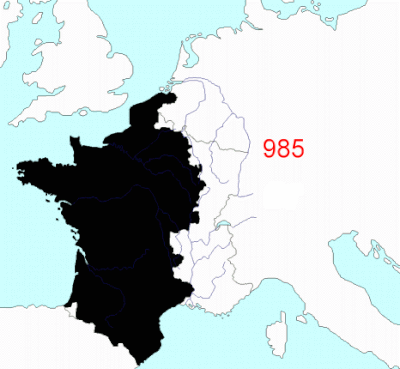
Back Εδαφικός σχηματισμός της Γαλλίας Greek Prantsusmaa territoriaalne areng Estonian Formation territoriale de la France métropolitaine French
This article needs additional citations for verification. (March 2011) |

This article describes the process by which metropolitan France - that part of France that is located in Europe, excluding its various overseas territories - came to consist of the territory it does today. Its current borders date from 1947.
Modern France is the successor state to the Kingdom of France, itself a successor to the Kingdom of West Francia, which came into being in 843 when the empire of Charlemagne was divided. Its rulers styled themselves as "King of the Franks", and their realm continued to be known as Francia, until king Philip II became the first to refer to himself as "King of France", in 1204.
Although in theory the medieval kingdom of France was not much smaller than the modern French Republic - stretching from the North Sea to the Mediterranean, and from the Atlantic Ocean to the Alps - the reality was that the king's direct authority was limited to a small area around Paris known as the île de France. The rest of the kingdom was made up of numerous all but independent fiefs ruled by the king's vassals: dukes and counts who owed him their loyalty and allegiance. To what extent areas like the County of Toulouse or the Duchy of Aquitaine can be considered part of the Kingdom of France before they were conquered by the king's armies is debatable. An integral part of the Kingdom of France's evolution through the Middle Ages is the story of how the Capetian kings, and their successors the Valois, brought these areas already in the kingdom under direct royal control, either through conquest, purchase or inheritance. Meanwhile, the acquisitions of the counties of Dauphine in 1349, and Provence in 1486, saw at once both the Royal Domain and the Kingdom of France expand their frontiers into the south-east, with both having previously been fiefs of the neighbouring Holy Roman Empire.
In 1066 Duke William of Normandy conquered England, making him and his successors simultaneously kings of England and - technically at least - vassals of the king of France. However, their loyalty and obedience to him was hardly a likely prospect, and the attempts of English kings to both directly control and expand their French territories sparked a succession of wars during the Late Middle Ages. On the one hand, the cost of defeat in battle could have calamitous consequences, and leave even more territory in English hands. But on the other, these wars served to unite the French feudal lords against a common enemy, and the king could use their military assistance to help conquer territory on behalf of the crown. Moreover, the wars with England - in particular the Hundred Years War, from which France ultimately emerged victorious in 1453 - helped forge a sense of French national identity.
At the beginning of the Early Modern Period, the final feudal lordships were absorbed into the royal domain, along with the large duchies of Brittany and Burgundy. By now France had become a much more centralised state, with its king exercising absolute power. Although attempts at expanding into the Italian peninsula and the Low Countries at the expense of the increasingly powerful Habsburg dynasty were ultimately unsuccessful, France's victory in the Thirty Years' War over Hapsburg Spain and Austria cemented its position as the foremost power on the European continent. There followed a series of annexations during the reign of Louis XIV that greatly expanded the Kingdom of France in the north and in the east, such as Artois in 1659, Alsace in 1675, and Franche-Comté in 1678. However, only a small part of the wealthy County of Flanders, lost to the Habsburgs in 1493, was regained in 1668.
The Duchy of Lorraine remained some time an enclave in the French kingdom before it too was incorporated in 1766. But for a few smaller enclaves, this brought the territory of the kingdom into a consolidated block, known today as "l'Hexagone". Meanwhile, the island of Corsica, a long-time procession of the Republic of Genoa and briefly an independent republic, was conquered in 1768.
Following the revolution, the new republic annexed the last remaining exclaves surrounded by France, such as the papal territory of Avignon, and conquered the former Austrian Netherlands (modern day Belgium) and Luxembourg. Faced with war against virtually all the other nations in Europe, France reached by far its greatest territorial extent during the early nineteenth century when the Emperor Napoleon incorporated the Dutch Republic, Catalonia, Dalmatia, and parts of Germany and Italy into the First French Empire. However following Napoleon's final defeat at Waterloo in 1815, France's borders were returned to where they had been in 1791 (but for the small enclaves annexed by the republic).
Since then, France has been invaded by Prussia and twice by Germany, but has regained any lost territories on each occasion (Alsace and Lorraine changing hands four times in the process). Thus the territory of the Metropolitan France that emerged from the aftermath of World War II almost exactly corresponded with that of France on the eve of the revolution.
Although Algeria was designated a department of France[clarify] in 1848, and remained so until its independence in 1962, it is not counted as part of Metropolitan France for the purposes of this article.
© MMXXIII Rich X Search. We shall prevail. All rights reserved. Rich X Search